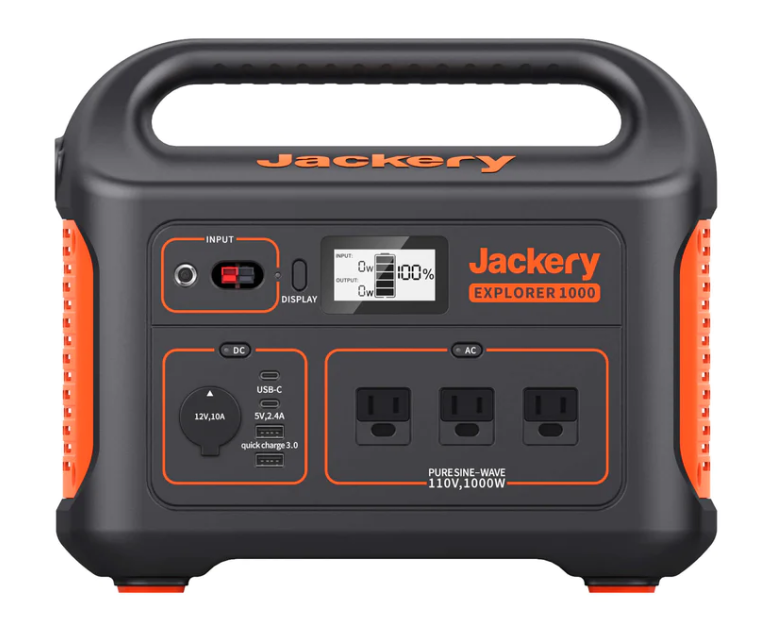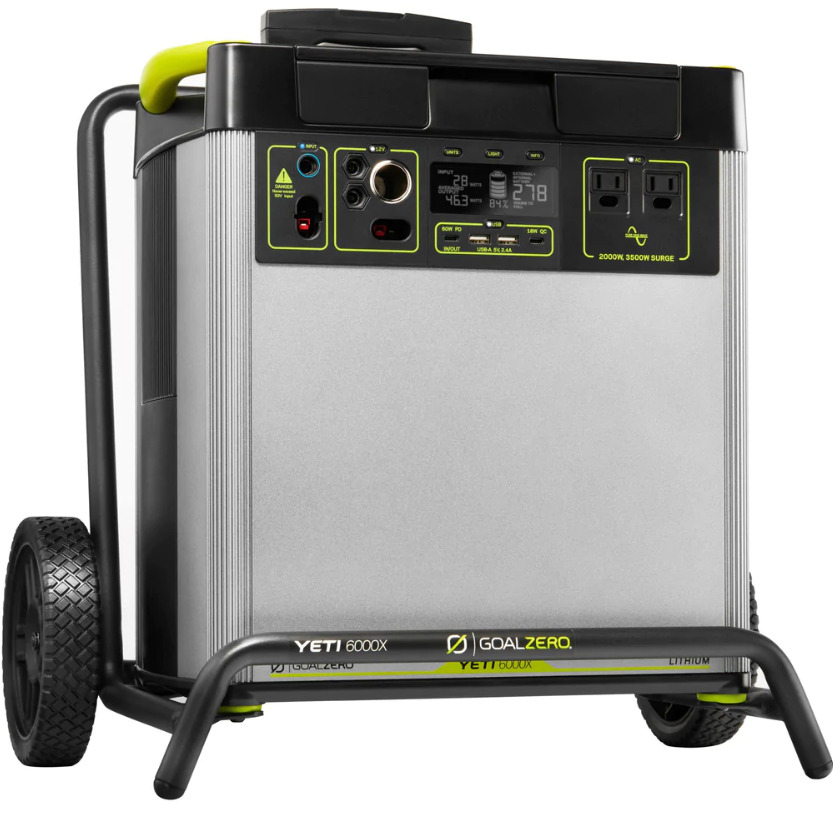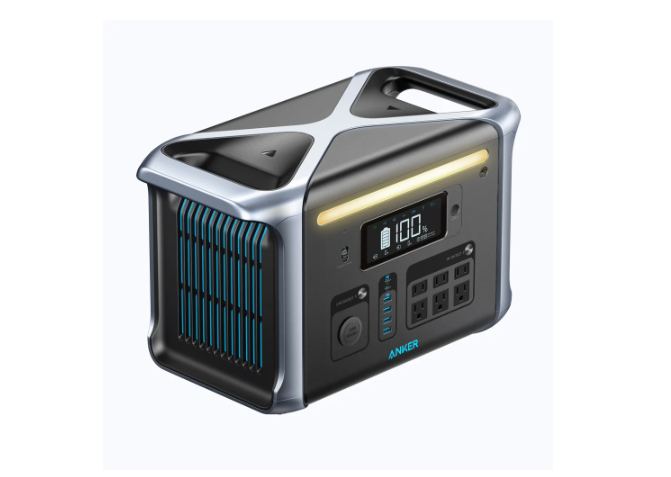Are you always on the road or need to access power in emergency situations? A portable power station is perfect for emergency power needs.
Portable power stations, what are they?
Portable power stations are sealed battery packs that can be hand-carried without difficulty wherever you go. They are more than your small power banks that can charge phones and other gadgets because power stations have larger energy capacities than can power the most essential appliances in your home while the power from the grid is shut off.
They may look like your gasoline-powered generators; only they are noise-less, smoke-less, and can be powered by solar panels.
How we evaluate
With all the portable power stations on the market today, we have come up with the top 5 based on their charging capacity, wattage for home use, user reviews, and solar compatibility.
Top 5 best portable power stations
To see the options for you, we have listed the top 5 best power stations for your home. We based this on quality, features, and value for money, giving you the best advice on your purchase. For more information, specifications, and updated pricing on the portable power stations we mention, check the links in the description box below.
1. Jackery Explorer 1000

What we love about this entry-level portable power station is its compact design, lightweight with multiple ports, including a carport.
With its 1,000W output capacity, it can power small to medium appliances like your blender, coffee maker, full-size refrigerator, mini cooler, TV, toaster, fan, and other outdoor or home needs.
Jackery Explorer 1000 can receive power from two solar panels simultaneously using an adapter cable. It has a much larger battery, so it’ll take longer to charge, but the ability to attach two solar panels can speed up the process. Two solar panels can take the battery charge from 0-80% in about 6.5 hours. However, this may not be an exceptional feature in charging performance, so how you use it matters. If it’s for emergency needs like unprecedented power outages, it can suffice to power your most essential appliances for at least a day.
Overall, it’s good value for money as it can power anything home for 24 to 36 hours. The price may vary, but it costs a little over $1000 without solar panels.
2. Ecoflow Delta 1300

The Delta Series can be dubbed the powerhouse of Ecoflow as it can meet the energy demands of whatever you think needs power backup. They have the smallest Delta Mini with capacity starting at 882 watt-hours up to the 25,000 watt-hours of the Delta Pro.
But the Ecoflow Delta 1300 is the better option if you are looking for good performance on a limited budget.
Ecoflow Delta 1300 can power your appliances and tools in case of emergency, like power outages. It is housed in high-grade aluminum and sturdy plastic with two carrying handles. It can take 1300 watts of charging and give 18000 watts of AC power output, allowing it to power most home appliances. Some examples are power lights, microwave ovens, electric kettles, frying pans, refrigerators, and CPAP machines. You can also charge your smartphones and Macbook multiple times.
What we like about the Ecoflow Delta 1300 is its fast charging capability. If you plug it into a standard AC wall outlet, it can be fully charged in over 1 hour. However, solar panels with 110W charging take between 14-28 hours to fully charge. That could be one of its weaknesses. One of the selling points is that you can power up multiple devices simultaneously.
Other downsides to it are its short battery life. While it charges fast, it only lasts 800 charges- too short for a supposed power backup. Based on user reviews, Delta 1300 also has shortfalls in its round-trip efficiency. One of the reviews indicated it has only 58% round trip efficiency, whereas other portable power has 79% efficiency. Meaning the battery outputs lesser than the total power stored in it. Therefore, this is recommended to be used occasionally, mainly in emergencies.
3. Bluetti AC200P

The first thing you will notice about this power station is how heavy it is. Is this still portable? But its look will make sense why this thing weighs a little over 60 lbs. Its casing is made of rigid flame-resistant plastic and aluminum, which justifies its weight.
But besides the issue of portability, Bluetti AC200P offers 2000 watts of continuous power. It means it can power a 100-watt computer, a 1000-watt fridge, and a 700-watt air fryer at the same time. In short, it has a lot of power to run your appliances and devices. Bluetti AC200P’s solar charging has a maximum charging load of 700W, meaning you can fully charge this power station in less than three hours. What we love about this is that you can have 3500 recharge cycles until its capacity drops to 80%. This means it will last almost 10 years even if you use it daily.
What adds more to the pros of this portable power station is its AC and DC input port that lets you charge it in five different ways. Through the AC wall outlet, solar, car, gas generator, and lead-acid battery. Plus, it has 17 output ports with a dust cover for protection. Who wouldn’t want that?
However, the biggest downside to this portable power station is its weight. If you need a power station, you could carry it around, then drop this from the list.
4. Goal Zero Yeti 6000x

If you are looking for a power station for emergencies, then Goal Zero Yeti 6000x might be the one. What we love about this compact power station is that it gives a 2,000-watt or 120-volt output that promises to keep a standard refrigerator running for 85 hours, your wifi router for 241 hours, and CPAP for 93 hours. Depending on what device or appliances you charge in an emergency, the Yeti 6000x will meet your expectations as an energy storage system backup. Yeti 6000x also doesn’t disappoint with its battery chemical makeup since it uses a lithium-ion battery pack, one of the industry’s most widely used battery technologies.
One of the reasons why people ditch gas generators is to opt for a clean and safe energy source, and Yeti 6000x delivers that. You can also charge this three-way: through solar, plug-in directly from an AC wall, or car. It also allows you to monitor, control, and optimize your power using the Yeti App 3.0, which you can download from your smartphone.
The most significant shortfall is that it cannot be fully charged in a single day from solar panels. Although it’s expected to have a slower solar charging time because of its large battery, it would have been better if it could recharge quickly. Plus, the weight of 104 lbs would be challenging for people to move around. Good thing it comes with a moving dolly, so it helps you move it. Additionally, while it has a massive battery capacity, its 500 lifecycles are only average compared to other power stations. Don’t be surprised by the price, though, as this costs $7,000, but we guarantee you get what you pay for.
5. Anker 757 Powerhouse

Anker, known for its charging accessories, now has a portable power station that gives off 1500W of power. This compact power station can charge your phones, laptops, fans, small appliances, electric grills, and even medical equipment.
Among its best features, the fast charging capability is why this is a winner. Anker 757 only takes 1.5 hours to fully charge this portable power station- extremely fast charging compared to others. It can also turn into an uninterrupted power supply (UPS), protecting your computers during power outages.
It also has features you can’t see from similar power stations- a power-saving mode and an external circuit breaker. The power-saving mode will automatically turn off once your devices are fully charged. This improves the efficiency of the Anker 757 Powerhouse. For additional safety measures, it has an external circuit breaker, which you can’t find on other generators.
Like other portable power stations, this one’s hefty in price, heavy, and has a smaller capacity than similar power stations.
Should you buy it? It’s one of the best options out in the market, especially with its unique features and fast charging capacity. It may be expensive, but worth the penny.
What to know before buying a power station
First, know what battery capacity and wattage you need. Battery capacity, written in watt-hours, means how long you can power your devices when fully charged. Generator wattage, given in watts, represents the maximum power you can plug in. Knowing these will let you know if the portable power station can power your devices for a period that suits your needs.
Second, check if you have the right solar panels. Portable power stations work with specific solar panels. Manufacturers often recommend solar panel options compatible with your power station, don’t forget to ask for that.
Third, list your charging time expectations and how many devices you need to plug into the portable solar station. Most portable power stations have 2 110V outlets, 1 12v car port, and a couple of USB ports. Ensure the power station’s number of ports is backed by a large inverter load and surge power.
Lastly, know the reason why you need a portable power station? How do you intend to use it? Is it for camping, outdoor activities, or emergency cases? Factoring all these will give you the best choice for the portable power station you need at home.
